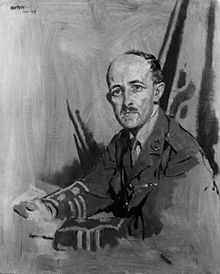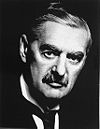- Maurice Hankey, 1st Baron Hankey
-
 Maurice Hankey as British Cabinet Secretary (1921)
Maurice Hankey as British Cabinet Secretary (1921)
Maurice Hankey, 1st Baron Hankey Chancellor of the Duchy of Lancaster In office
14 May 1940 – 20 July 1941Prime Minister Winston Churchill Preceded by The Lord Tryon Succeeded by Duff Cooper Maurice Pascal Alers Hankey, 1st Baron Hankey, GCB, GCMG, GCVO, PC (1 April 1877–26 January 1963) was a British civil servant who gained prominence as the first Cabinet Secretary and who later made the rare transition from the civil service to ministerial office.
Contents
Life and career
The third son of R. A. Hankey, Maurice Hankey was born at Biarritz in 1877 and educated at Rugby School. He joined the Royal Marine Artillery, was promoted Captain and served in successive roles including coastal defence analyst in the War Division of the Naval Intelligence Department (1902–1906). In 1908 he was appointed Naval Assistant Secretary to the Committee of Imperial Defence and became Secretary to the Committee in 1912, a position he would hold for the next twenty-six years. In November 1914 he took on the additional duty of Secretary of the War Council. In this function he took notice of the ideas of Major Ernest Swinton to build a tracked armoured vehicle and brought them to the attention of Winston Churchill on 25 December 1914, leading to the eventual creation of the Landship Committee.
In December 1916 David Lloyd George became Prime Minister and shook up the way the government was run. A small War Cabinet was instigated and Hankey was appointed as its Secretary. He also served as Secretary of the Imperial War Cabinet (which also incorporated representatives of the Colonies and Dominion governments) and gained a reputation for strong competency, so much so that when the full Cabinet was restored in 1919, the secretariat was retained and Hankey served as Secretary to the Cabinet for the next nineteen years. In 1923 he acquired the further position of Clerk of the Privy Council. During his long tenure he would also often serve as British Secretary to many international conferences and Secretary-General of many Imperial Conferences.
In August 1938 Hankey retired from government and became a British Government Director of the Suez Canal Company, a post he would hold for only one year. In the New Year's Honours List of 1939 he was ennobled as Baron Hankey, of The Chart in the County of Surrey. Lord Hankey remained a respected figure and was often consulted by ministers and civil servants for advice. In August 1939 he advised Neville Chamberlain about the formation of a new War Cabinet and the following month become another of Chamberlain's many non-party political appointments when he was made Minister without Portfolio and a member of the War Cabinet. Hankey was personally reluctant to take on this task but agreed to do so. He became Chancellor of the Duchy of Lancaster when Chamberlain was succeeded by Winston Churchill in May 1940, but was left out of Churchill's War Cabinet. In July 1941 Lord Hankey was moved to the position of Paymaster-General, but the following year he was dropped from the Government altogether. He continued to hold other positions in both the public and private sector until his death.
Hankey kept a series of at times startlingly detailed handwritten diaries throughout most of his years in government, including during his time as Secretary to the War Council and Imperial War Cabinet of the First World War. These diaries are currently held at the Churchill Archives Centre in Cambridge UK, and can be read by the public.
Maurice Hankey's youngest brother Donald Hankey was a soldier best known for a series of essays he wrote while serving on the western front in World War I. Donald died in action at the Somme.
Offices held
Government offices Preceded by
Charles OttleySecretary to the Committee of Imperial Defence
1912-1938Succeeded by
H L IsmayNew office Cabinet Secretary
1916–1938Succeeded by
Sir Edward BridgesPreceded by
Sir Almeric FitzRoyClerk of the Privy Council
1923–1938Succeeded by
Sir Rupert HoworthPolitical offices Preceded by
The Lord TyronChancellor of the Duchy of Lancaster
1940–1941Succeeded by
Duff CooperVacant Paymaster-General
1941–1942Succeeded by
Sir William JowittPeerage of the United Kingdom New creation Baron Hankey
1939–1963Succeeded by
Robert HankeyFurther reading
- Roskill, Stephen (1970). Hankey: Man Of Secrets. Volume I (1877-1918). Collins. ISBN 0-00-211327-9.
- Roskill, Stephen (1972). Hankey: Man Of Secrets. Volume II (1919-1931). Collins. ISBN 0-00-211330-9.
- Roskill, Stephen (1974). Hankey: Man Of Secrets. Volume III (1931-1963). Collins. ISBN 0-00-211332-5.
External links
- Spartacus Educational article
- The Papers of Lord Hankey are held at the Churchill Archives Centre in Cambridge, and are accessible to the public.
Paymasters General Parnell · Stanley · Knatchbull · Baring · Macaulay · Granville · Stanley · Colchester · Stanley · Pleydell-Bouverie · Lowe · Donoughmore · Lovaine · Wilson · Cowper · Hutt · Goschen · Monsell · Cave · Dufferin · Childers · Adam · Cave · Plunket · Wolverton · Beauchamp · Thurlow · Beauchamp · Brownlow · Jersey · Windsor · Seale-Hayne · Hopetoun · Marlborough · Crossley · Causton · Ashby · Strachie · Newton · Henderson · Compton-Rickett · Walters · Vacant · Chamberlain · Joynson-Hicks · Boyd-Carpenter · Gosling · Vacant · Sutherland · Onslow · Arnold · Vacant · Walters · Rochester · Hutchison · Munster · Winterton · Vacant · Cranborne · Vacant · Hankey · Jowitt · Cherwell · Vacant · Greenwood · Marquand · Addison · Macdonald · Cherwell · Selkirk · Vacant · Monckton · Maulding · Mills · Brooke · Boyd-Carpenter · Wigg · Vacant · Shackleton · Hart · Lever · Eccles · Macmillan · Dell · Williams · A. Maude · Pym · Parkinson · Gummer · Clarke · Brooke · Caithness · Ryder · Belstead · Cope · Heathcoat-Amory · Willetts · Bates · Robinson · Primarolo · Jowell · F. MaudeSecretaries of the Cabinet Colonel Maurice Hankey · Sir Edward Bridges · Sir Norman Brook · General Sir Hastings Ismay · Sir Burke Trend · Sir John Hunt · Sir Robert Armstrong · Sir Robin Butler · Sir Richard Wilson · Sir Andrew Turnbull · Sir Gus O'DonnellCategories:- 1877 births
- 1963 deaths
- Secretaries of the Cabinet (United Kingdom)
- Clerks of the Privy Council
- Barons in the Peerage of the United Kingdom
- Chancellors of the Duchy of Lancaster
- Members of the Privy Council of the United Kingdom
- Knights Grand Cross of the Order of the Bath
- Knights Grand Cross of the Order of St Michael and St George
- Knights Grand Cross of the Royal Victorian Order
- Royal Marines officers
- Fellows of the Royal Society
Wikimedia Foundation. 2010.



